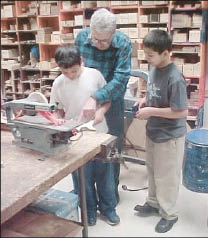In the parlance of the field, they are called “lifers.”
They are people who as children joined youth organizations and basically never left. Decades later, they are professionals dedicating themselves to better the lives of young people in the same groups that once nurtured them. They are not in it for money, they say. For them, it’s a labor of love.
| See Related Youth Career Profiles Michael Waldman |
| Sheavaun Malone |
| Carla Shelton |
| De’Janaria Austin |
| Paco Fuentes |
Ask any youth professional how he or she got started in the organization, and often the connection goes way back.
“I think there are quite a bit of . . . us who’ve been around for a while, people who are still in Boys & Girls Club work, running local clubs and on the national staff,” says Glenn Permuy, senior vice president of services for Boys & Girls Clubs of America. Permuy grew up in the West Tampa, Fla., Boys Club, which he later ran as CEO before moving to the national office in Atlanta.
The profiles that follow provide a glimpse of what motivates people to dedicate their lives to this single endeavor. Youth work is filled with people like them: Michael Waldman, vice president and chief operating officer of the Jewish Community Center in San Antonio, who first joined the center as a child in Minnesota; Paco Fuentes, who directs the Boys & Girls Club in his old South Omaha neighborhood; Sheavaun Malone, who started as a Salvation Army kid in Alaska and now holds a senior post in California; De’Janaria Austin, a military brat who runs the youth sports program at Nellis Air Force Base in Las Vegas; and Carla Shelton, who heads the church-affiliated youth organization she attended as a child in West Philadelphia.
 |
|
Building a life: John Welke entered a settlement house at age 8, and still teaches woodworking there as he nears his 80th birthday. |
The Paths
A lot of the stories sound like those told by Ryan Schmiseling: “I never planned to be a 4-H professional,” says the national program leader for 4-H youth development.
Now 36, Schmiseling joined 4-H in the fourth grade, in rural west-central Ohio. He was initially inspired by his mom, a 4-H volunteer, and his dad, who had grown up in 4-H.
While working on a master’s degree at Ohio State, Schmiseling held a graduate assistantship in the 4-H office. “That got me started,” he says.
Permuy, of the Boys & Girls Club, was 5 when he began going to his local club, where his father coached basketball and taught woodwork as a volunteer. Now 59, Permuy has worked for the organization since he was 16.
“I think there’s such a benefit we realize as young men growing up in the club,” he says. “Had it not been for my boys club, I would not have gone to college.”
Chicagoan John Welke truly exemplifies lifers. Born in March 1929, when he entered the Northwestern University Settlement House in his downtown neighborhood at age 8.
After graduating from Crane Tech, a vocational high school, Welke worked for the railroad as a carpenter. Laid off, he offered to help at the Settlement House. He volunteered but was soon hired to teach what he knows best: woodworking.
Welke has been at it for more than 48 years.
“The girls make Barbie doll beds and sofas and tables for Barbie dolls; the boys make airplanes, spaceships, napkin or paper towel holders for mom,” he says. “The kids don’t miss the computer games in my shop.”
“I am the longest-serving here. The next longest attended my woodshop classes when she was a child.”

























